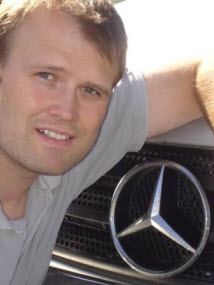
|
Lars Imsland is developing driver-support systems which are about to undergo trials in Mercedes test cars. The results of his work will be available to the whole of the automotive industry. |
Imsland and four fellow scientists make up the SINTEF/NTNU team in an EU research project in which the Mercedes parent company Daimler Chrysler is the industrial partner.
Modern vehicles contain a large number of built-in computers. The project aims to develop software for use both in anticollision systems and in systems designed to prevent car from turning over. In both systems the vehicle itself takes command when it is physically impossible for the driver himself to react sufficiently rapidly and appropriately.
Seminar on everyday technology
On Friday August 26, SINTEF is organising a seminar on everyday technology in Trondheim, at which this is one of the project that will be discussed.
Numerical software in vehicles
A number of modern cars are already fitted with anti-skid systems - technology that corrects the course of the car even before it loses its grip on the road. Some cars are also fitted with anti-rollover systems. These systems obtain their information from sensors that measure acceleration, how far the steering wheel has been turned and how fast each of the wheels is turning.
The scientists from Trondheim are developing a system that performs further, extremely rapid, processing on the data from these sensors.
Mathematical evidence
The system being developed by the Norwegian scientists uses information from the sensors to calculate the forward and lateral speeds of the vehicle, as well as the extent and speed of any roll. These are measures that the car’s own computer needs to have if it is to avoid collisions and rollovers.
“There are two aspects that distinguish our solution from existing systems. We have mathematically demonstrated that the estimated velocity is correct. At the same time, our solution does not require a great deal of computing power, which means that safer cars need not be too expensive”, says Imsland.
Key information
The core of an anticollision system will consist of a camera and radar that warn the vehicle of imminent danger. Messages will be sent from several integrated computers to tell each of the wheels how much they need to brake. For these messages be correct, the car must know its own speeds both forwards and sideways, which is where the Norwegian contribution comes in.
Next stage: test vehicles
Apart from Imsland, the SINTEF/NTNU project group consists of Professors Tor Arne Johansen and Thor Inge Fossen, PhD student Johannes Tjønnås and student Håvard Fjær Grip.
Imsland does not hide his pleasure in helping to develop the car of the future.
“It is almost frightening to think that the quality of my work will determine whether our systems are capable of saving lives”, he smiles, hastening to add that he finds the project highly exciting.
“Daimler is so interested in the results of our project that we will soon have permission to install the first version of the system in Mercedes test vehicles, which should be very interesting”.
Contact:
{DynamicContent:Ansatt link}
By Svein Tønseth
